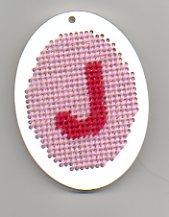
Updated September 20, 2022.
You probably don’t think about it much, but you can do needlepoint, or cross stitch for that matter, on anything that has holes in a grid-like structure. Usually, we stitch on canvas which is a grid-like cloth.
But I’ve seen stitching on pegboard, screen doors, furniture, car doors, and park benches, just to name a few. Why you can even drill holes in a bowl and stitch it, as you can see from the picture here. There is a Spanish artist who puts wire grids on the outside of buildings and covers them with stitched weather-proof designs.
With the rise of kits to stitch on wood and lucite as well as many companies making wood “blanks” for cross stitch, it’s good to take a minute to talk about what you need to know to stitch on rigid grounds.

If you have used plastic canvas or perforated paper before, most of this will not be new to you. Although thicker, rigid grounds share many of the same characteristics.
- The item will not have wide margins and cannot be stitched with a frame. You will have to hold it (this may be uncomfortable for some people.
- The holes are the holes; you can’t expand them at all to fit thicker threads or a bigger needle.
- Because it’s rigid, you can use Half Cross Stitch here. It can’t distort the item and the material usually is opaque enough that the lighter coverage won’t be a problem.
- Your back will show unless you glue something like felt over it, so be neat.
- Although you can make any stitch on these grounds, often simpler is better.
- Once the stitching is complete, you are either finished or can finish it quickly yourself.
Be adventurous; try stitching on a rigid ground today!
About Janet M Perry
Janet Perry is the Internet's leading authority on needlepoint. She designs, teaches and writes, getting raves from her fans for her innovative techniques, extensive knowledge and generous teaching style. A leading writer of stitch guides, she blogs here and lives on an island in the northeast corner of the SF Bay with her family

Leave a Reply